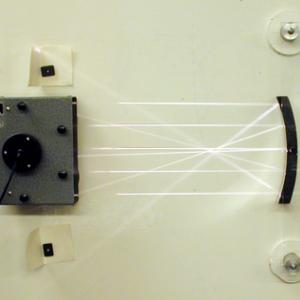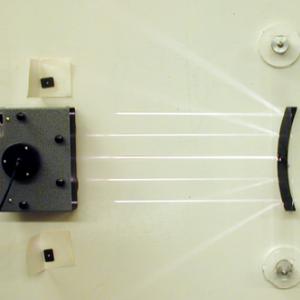College of Liberal Arts & Sciences
6A20.10 - Mirrors - Blackboard Optics - Curved Mirrors
Video Credit: Jonathan M. Sullivan-Wood
The blackboard optics unit is pretty self explanatory, however there is a pamphlet on its use with the unit and in the file. Do Not run the power supply for the light bulb over 12 volts.
Dry erase markers are in the drawer on the B.B Optics Unit.
- Nuri Balta, "Gaussian Formula for Ray Tracing in Lenses and Mirrors", TPT, Vol. 60, #1, Jan. 2022, p. 56.
- Lasse Heikkinen, Antti Savinainen, and Markku Saarelainen, "Virtual Ray Tracing as a Conceptual Tool for Image Formation in Mirrors and Lenses", TPT, Vol. 54, #9, Dec. 2016, p. 538.
- Thomas B. Greenslade, Jr., "A Quick Experiment on Reflection from Concave Mirrors", TPT, Vol. 38, # 4, Apr. 2000, p. 206.
- David Heiden, "Seeing the Light, an Alternative to Chalk Dust", TPT, Vol. 35 # 1, Feb. 1997, p. 94.
- Se-yuen Mak, "Low-Cost Cylindrical Mirrors", TPT, Vol. 31, # 3, Mar. 1993, p. 186.
- Samuel Derman, "Ray Tracing with Spherical and Parabolic Reflectors", TPT, Vol. 28, # 9, Dec. 1990, p. 590.
- Bill F. Melton and Terrill W. Mayes, "Plastic Concave and Convex Cylindrical Mirrors", TPT, Vol. 21, # 2, Feb. 1983, p. 125.
- Kenneth Fox, "Finding the Principal Focus with Laser and Thread", TPT, Vol. 19, # 7, Oct. 1981, p. 480.
- Robert Gardner, "Ray Models of Concave Mirrors and Convex Lenses", TPT, Vol. 18, # 8, Nov. 1980, p. 608.
- Oc-1,2,3: Freier and Anderson, A Demonstration Handbook for Physics.
- O-150: "Diverging-Virtual Image Always", DICK and RAE Physics Demo Notebook.
- O-155: "Virtual or Real Image?", DICK and RAE Physics Demo Notebook.
- O-555: "Poisson's Spot", DICK and RAE Physics Demo Notebook.
- Janice VanCleave, "8, Directors", Engineering For Every Kid: Easy Activities That Make Learning Science Fun", p. 59.
Disclaimer: These demonstrations are provided only for illustrative use by persons affiliated with The University of Iowa and only under the direction of a trained instructor or physicist. The University of Iowa is not responsible for demonstrations performed by those using their own equipment or who choose to use this reference material for their own purpose. The demonstrations included here are within the public domain and can be found in materials contained in libraries, bookstores, and through electronic sources. Performing all or any portion of any of these demonstrations, with or without revisions not depicted here entails inherent risks. These risks include, without limitation, bodily injury (and possibly death), including risks to health that may be temporary or permanent and that may exacerbate a pre-existing medical condition; and property loss or damage. Anyone performing any part of these demonstrations, even with revisions, knowingly and voluntarily assumes all risks associated with them.

